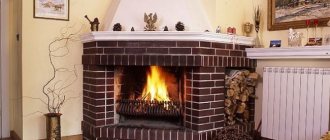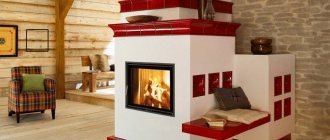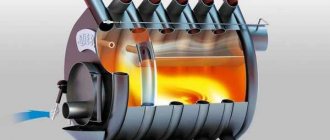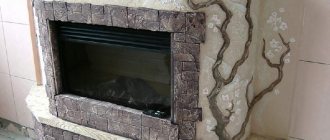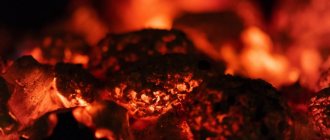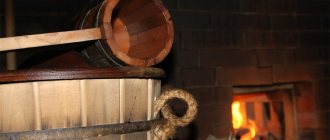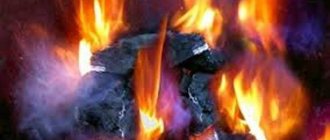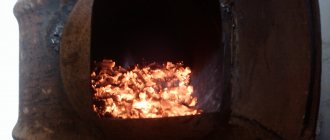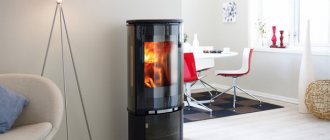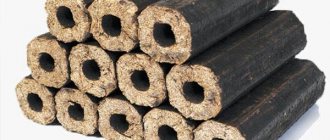In one of our materials we talked about cast iron stoves for the Karelia bathhouse. Today we decided to return to the topic of sauna stoves and introduce our readers to the products of the Litkom enterprise, which it produces under the Vesuvius brand.
The Vesuvius line of Litkom stoves appeared as a result of the company’s specialists studying the most popular models from Finnish and Russian manufacturers. The model range of this brand is constantly expanding, since the manufacturer, improving its production capabilities, strives to fully satisfy the needs of bathhouse owners and lovers of bathing procedures.
Litkom produces not only sauna stoves. Customers are also offered a large selection of heating units for the home, chimneys with components for them, heat exchangers, water tanks, and accessories for stoves. Such an abundance of products provides customers with the opportunity to improve, as necessary, the units they already have or purchase new units to replace outdated or damaged ones, while remaining within a single brand.
What is the highlight of Vesuvius and the main features of stoves of this brand
The main feature and highlight of Vesuvius is the roundness of these stoves, completely devoid of corners. This form was chosen by the designers because it contributes to a more uniform distribution of the heat produced by the furnace in space. A welded structure made of high-strength steel elements 8 mm thick is used as the outer casing.
Bath stoves "Vesuvius" are recognizable due to the roundness of their shapes (top view)
The ability to place stones in a round mesh structure ensures their more uniform heating, as well as softening the harshness of the infrared radiation of a metal firebox. The presence of a special silicone layer covering the surface of Vesuvius stoves ensures their protection from the corrosive effects of water, which is aggravated by the high temperature usual for a bath.
The chimney diameter of all Vesuvius stove models is 115 mm. As we noted above, accessories for chimneys and the necessary components can be purchased from the “native” series, since the Litcom enterprise is engaged in the production of these products. If the design of your bathhouse involves the process of heating from adjacent rooms, then when purchasing, you must take into account that for all models the combustion tunnel has a standard length of 290 mm.
"Vesuvius" with open or closed heater: the choice is yours
Since the structure for laying stones is located outside, it should be understood that it is unable to provide steam with the humidity that the very concept of “Russian bath” in its classical interpretation implies. If you are a fan of a real Russian steam room, with its inherent humidity and high temperature, then consider purchasing models that have a closed heater. If you love the specifics of the Russian bathhouse, but you are still attracted by the appearance of an open heater, the appearance of the stones laid in it, then you will have to acquire additional devices and fixtures, examples of which we will describe below.
According to experts, in an open-type heater there are no conditions for the stones to heat up to a temperature level that would make the steam really light. If the furnace power is high enough, it provides good heating of the stones. However, since the stones are open, they quickly release their heat into the steam room. This state of affairs makes the bathhouse more similar not to a Russian, but to a Finnish dry-air sauna.
It is easy to pour water onto stones placed in an open heater, but the resulting steam turns out to be “heavy”. To provide the couple with the desired “lightness,” bath professionals lay tubes between the stones that go deep into the stone mass, and through them water or herbal infusions are supplied. Since the temperature of the stones located near the firebox is much higher, the steam they produce is drier. Rising through the layer of stones laid on top, the steam is additionally dried and becomes finely dispersed, i.e. it turns into that “light” steam that is typical for a Russian bath.
However, this improvement of the heater using tubes is far from ideal: a heated stove does not allow you to calmly strain water into the tubes laid for this purpose, and there is a high risk of getting burned by the escaping clouds of steam. The matter is complicated by the fact that initially the tubes are laid purely intuitively. If the laying result is unsatisfactory, the stones have to be re-laid in order to move the tubes inserted into their mass. Thus, this improvement can only result in additional hassle for those who like to steam.
In our opinion, stove models with a closed heater are the most suitable option for steam rooms, called Russian. However, greater convenience of their use is achieved provided that the open part of the heater can be closed and covered, which ensures regulation of heat transfer and heating of the stones themselves.
Preparation, bookmarking and checking
Without knowing how to properly heat a stove with wood, it is important to carry out all the preparatory work; for this, buy and prepare in advance such tools as:
- A poker of a certain length, which depends on the size and depth of the firebox;
- Scoop made of fireproof and lightweight materials, such as tin. Its width should be less than the blower chamber;
- Mittens made of canvas; this material is highly durable and has optimal thickness. They are used in the process of kindling and operating the heating unit, protect your hands from burns, and allow you to touch heating structural elements.
Preparation of fuel is a separate and one of the most important points, the wood itself can be very diverse, it is important to properly prepare and store it, the humidity in the firewood will be minimal, since products with high performance burn poorly, produce a small amount of thermal energy and a lot of soot, soot, smoke.
Many people believe that coal can be used as a fuel - this is indeed true, however, contrary to popular misconceptions, it cannot be wetted, since the combustion process will be better only until the moisture has completely evaporated as a result of exposure to fire. It is important to use high-quality coal, which will be in lumps and not dust, which is not suitable for lighting stoves and fireplaces.
At the second stage of the preparatory work, it is necessary to check the functionality of the traction mechanism; to do this, pull out the chimney damper, which is used in the warm and summer seasons. Now put your hand there and if you feel a noticeable flow of wind, a draft, then the thrust is working fully and at full power, which is what we need. If you do not feel the currents of advancing wind, you need to light a match, and then warm up the chimney channel by burning paper through the cleaning door, which is located at the bottom of the chimney.
You may also be interested in reading the following article: “Which is better, a boiler or a fireplace for heating a house.”
After you have cleaned the chimney channels and the draft has normalized its correct and efficient operation, it is necessary to clean the structure of all contaminants and combustion products, in this case we will need to use a poker.
At the third stage, it is necessary to add fuel to the fireplace; for this you can use any wood, the main requirement for it is good dryness and a minimum of moisture in the composition. In order for your firewood to initially fully meet all these criteria, it is important to arrange a place for storing it with a low level of humidity, preferably not on the street.
Before loading fuel into the fireplace, it is necessary to chop it into approximately equal and small logs; you can also use the remains after repairs, for example, twigs, shavings, brushwood, and birch bark, for kindling.
Kindling is carried out according to the following rules:
| Photo | Stage, actions | Description |
| Bookmark the first layer | You need to crumple and put a sheet of paper or newspaper into the fireplace insert, then lay the second layer, which includes birch bark, and the third layer is one or more logs. | |
| Bookmark the second layer | After the flame in the hearth begins to flare up, firewood must be laid on top of the entire structure. This design should not occupy the entire space of the firebox, no more than 1/3 of it, since it is primary and not the main one. | |
| flaring up | Now you need to partially close the oven door and wait until the fire reaches the firewood, and then close the door hermetically. |
The second stage is the main laying, which will contribute to the active production of thermal energy, which is what we will support throughout the entire period. The firewood is stacked in the combustion chamber quite tightly to each other, completely occupying all the free space.
Without knowing how to properly heat a fireplace stove, it is necessary to completely cover the grate with wood, so the fuel will burn intensely, produce a large amount of heat, and air masses will flow through the grate into the hearth, supporting this process.
The second stowage is often carried out on large coals already formed after the first one. To do this, you will need to carefully open the combustion chamber, then use a poker to level the firebrands. Place firewood in the fireplace so that the compartment is not completely filled and there is about 10-15 centimeters of free space in the upper part. Now the firebox closes and the blower opens, the heating unit continues to operate, and the intensity and level of flame combustion is controlled using valves.
If coal is used as fuel, you must first place one layer of logs in the fireplace and only after that add coal, the layer of which will not be more than 10 centimeters. Wait until it burns well and add more coal, in a layer of 15 centimeters, maintain this thickness while the heating unit is operating.
Model ranges of Vesuvius stoves
Among those where an open heater is installed, the most spectacular and unusual are the models of the Vesuvius Vertical series. The external dimensions of all modifications are the same (WxDxH = 540x790x1010 mm), the difference lies in the design of the door covering the combustion tunnel. Some doors have panoramic glass or regular heat-resistant glass, others have no glass at all. This line, the cost of various models of which ranges from 12 to 20 thousand rubles, is capable of heating steam rooms with a volume of 8-18 m3.
Furnace Vesuvius-Vertical
"Vesuvius-Vertical"
The “Vesuvius Skif” and “Russian Steam” lines also have an open heater, which are distinguished by a wide variety of sizes and door designs. Thus, “Russian Steam” has six modifications that are capable of heating steam rooms ranging in size from 18 to 23 m3 and the average cost of which is in the range from 24 to 27 thousand rubles.
Furnace Vesuvius Skif
"Vesuvius Scythian", model SCH12
“Scythians” have 26 options that are capable of heating rooms of almost any size and which are distinguished by a wide variety of designs for the doors of the combustion portal. With an abundance of options, the price range is also wide - from 10 to 25 thousand.
Vesuvius Elite stove
"Vesuvius Elite", lined with coil
In Vesuvius Elite stoves, which attract attention with their appearance, their own coil plays the role of lining. The combustion tunnel door of these stoves is decorated with built-in glass. There are relatively few modifications in this series, and their prices start at 40 thousand rubles.
Vesuvius Lava Furnace
Sauna stove Vesuvius Lava
The line with a closed heater is represented by the popular Vesuvius Lava stove, the distinctive feature of which is the forged decorative linings that decorate the body. This series has a large number of modifications (currently there are 24), differing in power, overall dimensions, the presence or absence of a fuel tunnel, door glazing or its absence. Buyers can choose from this series such sauna stoves that are capable of heating steam rooms measuring 6-28 m3. The abundance of models also implies a wide range of prices, which range from 12 to 28 thousand rubles.
Furnace Vesuvius Rusich
"Vesuvius Rusich"
Sauna stoves "Vesuvius Rusich" are produced without forged elements on the surface of the body, but this does not matter for those bath lovers who intend to surround the stove with a brick screen, which improves the quality of the steam, which more fully meets the requirements of the Russian steam room. The price of the product is 16-18 thousand rubles.
Furnace Vesuvius Legend
Sauna stove Vesuvius Legend
The “Legend” line, made of cast iron, has a fairly significant weight (about 160 kg), has an open-type heater and a combustion tunnel. Such sauna stoves are capable of heating steam rooms measuring 10-28 m3. Various models cost from 14 to 23 thousand.
The advantages of Legend stoves are described in detail in the video we offer.
Video – Sauna stove Vesuvius Legend
Each line includes fireplace stoves equipped with doors with wide panoramic heat-resistant glass.
What wood is best to use for heating a sauna?
Birch is very good, it has high heat transfer, flares up quickly and burns for a long time. You can use oak, aspen, alder, apple, maple.
In terms of heat transfer, beech, oak and hornbeam are in first place. In second place is birch; due to its tar content, it burns superbly. In order for the birch to burn without soot, it is necessary to provide good air access to the oven. Otherwise, the soot will settle on the walls of the chimney, which can then lead to a fire.
In third place in terms of heat transfer are fruit trees, maple, alder and aspen. By the way, aspen is useful for burning out soot in the chimney. Its firewood can be used at the beginning of kindling.
Do not burn with coniferous wood. They secrete resin and make loud noises. Sparks may fly, creating a fire risk. The combustion process is quite slow. Such wood smokes heavily and emits carbon monoxide. Soot pollutes the chimney, which is then difficult to clean.
The wood must be dry or have no more than 30% humidity. It is difficult to heat with raw wood, it is not economical, and the bathhouse will not warm up very quickly. In addition, a lot of condensate is released, which settles in the chimney. The oven will smoke heavily.
Thin and medium logs should be used, no more than 8 cm in diameter.
You can use oak wood to fire the stove in the bathhouse.
Under no circumstances should you heat a bathhouse with old painted boards, rotten wood, or wood that has undergone any treatment. Moreover, you cannot throw garbage or any waste into the firebox.
It is also prohibited to use lighter fluids, either store-bought or gasoline with kerosene.
Vesuvius brand water tanks for sauna stoves
The basic equipment used in Vesuvius stoves does not include water tanks. However, you can freely purchase a water tank of the same brand that suits you.
Rectangular tanks are available for sale, both pipe-mounted (55-80 l) and hinged (60-125 l). Millimeter matte stainless steel is used for their manufacture. The G3/4 fittings are located on the sides of the tank or on its bottom.
| Rectangular tank on a pipe | Mounted oval tank | Oval tank for pipe |
Oval contour-type tanks of vertical or horizontal placement (60, 90 l), oval-shaped pipe tanks are made of mirror stainless steel 0.5-1.0 mm. The tanks are equipped with filling holes and G3/4 fittings.
In addition, Litcom also offers heat exchangers that can be round or flat (6, 12 l). They are made of stainless steel 0.5-1.0 mm and have G3/4 fitting connections.
